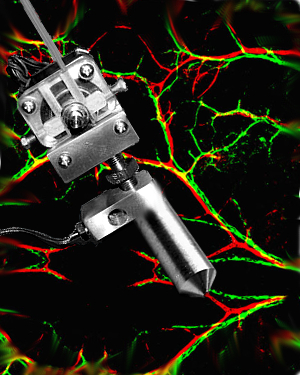Nerve repair achieved in 3D-printed sleeve
 Bio-engineers have a developed a 3D-printed implant that can help regrow damaged nerves.
Bio-engineers have a developed a 3D-printed implant that can help regrow damaged nerves.
Researchers in the US say their first-of-its-kind, 3D-printed guide can repair both the sensory and motor functions of complex nerves after injury.
They say it could help the hundreds of thousands of people who experience nerve injuries or disease each year.
Nerve regeneration is a very new and very complex process, and the full regrowth of nerves after injury or disease is very rare, meaning it is often permanent.
But the multi-university team working at the Mayo Clinic in Arizona say advanced 3D-printing methods may be the solution.
In a study published in the journal Advanced Functional Materials, researchers combined 3D-imaging and 3D-printing techniques to build a custom silicone guide.
It was implanted with biochemical seeds to prompt nerve regeneration, and tested in the lab using rats.
The researchers used a 3D-scanner to reverse engineer the structure of a rat's sciatic nerve. They then used a specialised, custom-built 3D-printer to print a guide for regeneration.
Have a look at the video below to see the exciting and advanced printer in action.
Incorporated into the guide were 3D-printed chemical cues to promote both motor and sensory nerve regeneration.
The guide was implanted into the rat by surgically grafting it to the cut ends of the nerve, and within 10 to 12 weeks, the rat's ability to walk was restored.
“This represents an important proof of concept of the 3D-printing of custom nerve guides for the regeneration of complex nerve injuries,” said University of Minnesota mechanical engineering professor Michael McAlpine, the study’s lead researcher.
“Someday we hope that we could have a 3D-scanner and printer right at the hospital to create custom nerve guides right on site to restore nerve function.”
Previous studies have been able to regrow linear nerves, but this is the first time engineers have achieved regrowth of a complex nerve like the Y-shaped sciatic nerve, which has both sensory and motor branches.
“The exciting next step would be to implant these guides in humans rather than rats,” McAlpine said.
In cases where a nerve is unavailable for scanning, McAlpine envisions the formation of a “library” of scanned nerves from other people or cadavers that hospitals could use to create closely matched 3D-printed guides for patients.
The project featured researchers from the University of Minnesota, Virginia Tech, University of Maryland, Princeton University, and Johns Hopkins University.
It was funded by grants from the National Institutes of Health, the Defense Advanced Research Projects Agency (DARPA), the Maryland Stem Cell Research Fund, and the Grand Challenges Program at Princeton University.







 Print
Print